A History of the County of Buckingham: Volume 4. Originally published by Victoria County History, London, 1927.
This free content was digitised by double rekeying. All rights reserved.
'Parishes : Shenley', in A History of the County of Buckingham: Volume 4, ed. William Page (London, 1927), British History Online https://prod.british-history.ac.uk/vch/bucks/vol4/pp445-451 [accessed 23 April 2025].
'Parishes : Shenley', in A History of the County of Buckingham: Volume 4. Edited by William Page (London, 1927), British History Online, accessed April 23, 2025, https://prod.british-history.ac.uk/vch/bucks/vol4/pp445-451.
"Parishes : Shenley". A History of the County of Buckingham: Volume 4. Ed. William Page (London, 1927), British History Online. Web. 23 April 2025. https://prod.british-history.ac.uk/vch/bucks/vol4/pp445-451.
In this section
SHENLEY
Senelai (xi cent.); Sanleia (xii cent.); Senle, Shenlegh (xiii cent.); Shendeley (xv cent.).
The parish of Shenley extends into the two hundreds of Newport and Cottesloe, to the south-west of Watling Street. The more important portion, the township of Church End, where St. Mary's Church is, lies in Newport Hundred, and has to the south of it the hamlet of Brook End in Cottesloe Hundred. These names have respectively replaced those of Great and Little Shenley in the 13th and 14th centuries, and of Lower and Upper or of Nether and Over Shenley from the 13th century onwards.
The areas of the township and hamlet have varied considerably during the 19th century. In 1831 there were 1,510 acres in Church End and 1,620 in Brook End, a total of 3,130 acres, (fn. 1) which between 1841 and 1851 had decreased to 2,900. A further decrease took place between 1861 and 1871, when the whole parish was assessed at 2,596 acres, of which only 935 were in Brook End. Another change occurred between 1871 and 1881, probably under the Divided Parishes Acts of 1876 or 1879, by which the area of Brook End was increased to 1,659 acres and that of Church End to 1,662 acres, the figures at which they stand at the present day. There are 276 acres of arable land, 933 of permanent grass and 167 of woods and plantations in Church End. (fn. 2) A 16th-century survey of Shenley Manor, which lay principally in Church End, speaks of Shenley Park (50 acres), Hangers (38 acres), Redocks Hill (14 acres), and Oakhill (16 acres) as woods 'all well sett with yonge oke.' (fn. 3) Howe Park in the south of Brook End was returned at 88 acres in the 17th century, (fn. 4) and is referred to in a deed of the 14th century. (fn. 5) The woodland in this part of Shenley is now only 65 acres in extent, the greater portion of the land, 1,032 acres, being laid down in grass, while there are 517 acres under cultivation. (fn. 6) The soil is alluvial and clay with a subsoil of stone and clay, producing cereals and beans. It is watered by brooks flowing from the higher land in the west (400 ft. above ordnance datum) to the lower lying fields (300 ft.) in the east of the parish.
Church End is pleasantly situated among trees on a road which crosses Watling Street, and branches west and south at St. Mary's Church and rectory. About a quarter of a mile south-west of the church is the Toot, a moated mound with two large moated inclosures, the whole covering some 7 acres. In the northernmost of the inclosures are traces of the foundations of the old manor-house of Shenley, pulled down in 1774 by Matthew Knapp, then lord of the manor. (fn. 7) The present principal landowner, Mr. Richard Selby-Lowndes, lives about a quarter of a mile north at Shenley Park (formerly Shenley House), a stone building which is approached through the park by an avenue of limes.
A short distance to the south of the church are the gabled almshouses of stone with tiled roofs, founded under the will of Thomas Stafford of Tattenhoe, who died in 1607, (fn. 8) and to whom there is a monument in the north aisle of Shenley Church. (fn. 9) He empowered his son and heir Thomas Stafford, his son-in-law Sir Arthur Savage and other trustees to build an almshouse or hospital for four men and two women in some town in Buckinghamshire 'of their own appointing,' and to endow it with lands worth £30 per annum. Each occupant was to have house-room and a garden plot and was to be given a gown with a red cross on the left sleeve every year, while the men received 3d. and the women 2d. each day. (fn. 10) As recorded on a panel in the middle gable of the building, the hospital was erected on land purchased in 1615 by Thomas Stafford the son, who intended to incorporate the almshouses by a deed poll of 25 February 1626–7. There was, however, no indorsement of enrolment of the deed poll. (fn. 11)
Of about the same date is the half-timber farmhouse south of the church. Folly Farm, a mile to the south-west, was built in the same century, but much of the brickwork is modern.
The hamlet of Brook End stands on higher ground about three-quarters of a mile south of the church, and is grouped round a green. To the west of it, in an isolated position surrounded by fields, is Westbury Farm, the site of the manor of that name. Part of the south wing is of the early 17th century, but the greater part of the building seems to have been constructed in 1670, the date inscribed on the south front. Roman remains consisting of part of a tessellated pavement and bricks were found in the neighbourhood at Dovecot Farm in January 1901.
Nether, Middle and Upper Fields in Shenley Brook End and part of East Green Common were enclosed by an Act of 1762, when an allotment was made to the rector in lieu of tithes. The award is dated 2 March 1763. (fn. 12) In 1841 Matthew Knapp, lord of Shenley Brook End Manor, was allotted the value of William Selby-Lowndes's chase rights over Shenley Common in part compensation for similar rights over Whaddon Chase relinquished by Matthew Knapp. The said allotment was to be fenced in from the rest of the common. (fn. 13) By an award having date 7 November 1851, Shenley Common was still further enclosed under an Act of 1845. (fn. 14)
Among place-names have been found: Hartdames, Bushey Bartrams, Fedys, Rowlak's Hill, Tatnyllmill, (fn. 15) the Brothered Land, Collet Wyke (fn. 16) (xvi cent.); Town Street, the Pickle and Calves, Mare Pitts (fn. 17) (xvii cent.); Fulmore, Bennetty Leys, (fn. 18) Carter's Farm (fn. 19) (xviii cent.).
Manors
Two manors in Shenley of 5 and 2 hides respectively, both held in the time of Edward the Confessor by Baurchard, his thegn, were included in 1086 among the lands of Earl Hugh (fn. 20) (Earl of Chester). As one fee of the honour of Chester, or, as it was known from its later holders, the honour of Arundel, (fn. 21) Shenley was subordinate to Olney Manor, the chief possession from the early 13th century of the Earls of Chester in this county. (fn. 22) The descent through the Earls of Arundel, the Bassets of Drayton and Beauchamps and Nevills, Earls of Warwick, has been given under Olney (q.v.), with which the overlordship rights in Shenley were transferred to the Crown in 1488. In 1542 Shenley was included in the honour of Grafton, (fn. 23) and was held of the Crown for one-twentieth fee until the 17th century. (fn. 24)
From Hugh, the earl's tenant in 1086, (fn. 25) these two manors passed as one estate to the family of Maunsell. The William who paid half a mark for Shenley in 1167 (fn. 26) may be the William Maunsell who in 1183 paid 2 marks for licence to sue John de Caverton for land in Shenley. (fn. 27) In 1198 7 virgates in Shenley were quitclaimed by Robert son of Ralph to Thomas Maunsell, (fn. 28) to whom Nicholas Maunsell quitclaimed a rent of 40s. in the same year. (fn. 29)
In 1223 (fn. 30) and 1229 (fn. 31) Thomas Maunsell presented to the church, and he or a successor of the same name paid scutage for Shenley in 1236 (fn. 32) and was returned as lord of the vill in 1254. (fn. 33) Thomas Maunsell supported Simon de Montfort against the king, and it was probably during his absence that John de Grey about 1276 seized the manor, which he wasted, appropriating all he could and selling part. (fn. 34) Shenley was forfeited and granted to William de Aette (Ayet or Eyet), in accordance with the 'Dictum of Kenilworth.' (fn. 35) It was demised by William to Isabel de Albini, Countess of Arundel, the overlord, and by her granted, together with the custody of the heirs of Thomas Maunsell during their minority, to Richard de la Vache, (fn. 36) who was therefore the lord of Shenley in 1278, (fn. 37) and who acquired land there in that year. (fn. 38) Thomas Maunsell had left two daughters, Mabel, whom Richard de la Vache married to his son Richard, and Alice, who about 1283 married Robert Verdon (fn. 39) without her guardian's permission, and entered on certain lands in Shenley which Margery widow of Thomas Maunsell held in dower. (fn. 40) This led to trouble with Richard de la Vache the elder, against whom the Verdons brought a suit in 1284 to obtain possession of their moiety of the manor, (fn. 41) and both Richard de la Vache the elder and the heirs of Thomas Maunsell laid claim to the manorial rights in Shenley that year. (fn. 42) In 1285 both sisters and their husbands redeemed their father's lands from William de Aette (fn. 43) and divided Shenley between them, the moiety appertaining to the Vaches being settled by them in the following year on Robert de Broughton. (fn. 44) It was seized by the Crown for their default against Thomas Poyle, and an attempt to regain it in 1290 evidently succeeded, (fn. 45) for in 1294 Richard de la Vache was dealing with land in Shenley, (fn. 46) and in 1308 he settled his Shenley property on himself for life, with remainder successively to his sons Matthew and Richard and his daughter Maud and their heirs. (fn. 47) Matthew succeeded to Shenley before 1316, (fn. 48) and in 1326 a settlement was made by Walter de la Vache of a messuage and 24 acres of land in Shenley on himself for life, with remainder successively to William son of Wymark of Shenley, to Joan sister of William, to Walter son of Matthew de la Vache, Thomas his brother and Walter's heirs. (fn. 49) The Vaches' moiety of SHENLEY MAUNSELL MANOR, so-called during the 14th and 15th centuries, (fn. 50) descended with their manors in Aston Clinton and Chalfont St. Giles with which it was included in the settlements in the late 14th and early 15th centuries. (fn. 51) It passed with Aston Clinton to the Kirkhams, and after the death of Anne Kirkham, then a widow, in 1427 (fn. 52) was held by a John Kirkham, who is described as of Shenley in 1435. (fn. 53)
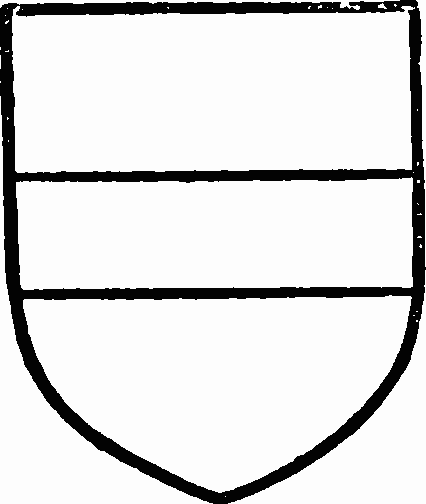
Maunsell. Gules a fesse argent.
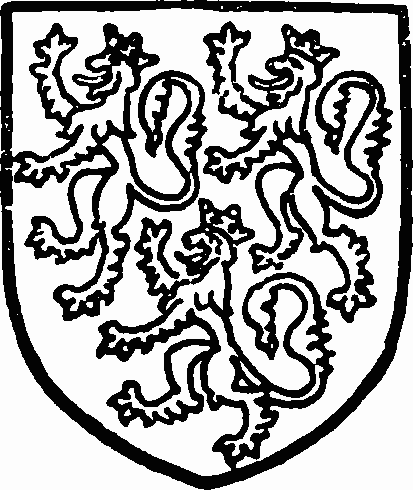
Vache. Gules three lions argent having golden crowns.
As in Aston Clinton so also in Shenley, the manorial rights were claimed by Reynold Lord Grey de Wilton on the death in 1442 of his father Richard, (fn. 54) to whom Reynold's mother, the Vache heiress, had brought the manor in marriage. (fn. 55) After a dispute with his stepmother Margaret, (fn. 56) on whom this moiety as well as the other (see later) had been settled, (fn. 57) Reynold in 1447 acknowledged her life interest and that of her second husband, Sir Thomas Grey, to VACHES MANOR in Shenley, first so-called. (fn. 58) She died early in 1451–2, and was survived by Sir Thomas Grey, (fn. 59) probably a few years only, as Vaches reverted to Reynold Lord Grey de Wilton, by whom it was alienated in 1456 to Thomas Grey, Lord Richemount, the owner since before 1452 of the other moiety of Shenley called Verdons (q.v.), Reynold's renunciation of right therefore applying to the whole manor of Shenley called Vaches and Verdons. (fn. 60) The two manors henceforward remain in the same ownership, but the distinction between them was maintained, the names of Vaches and Verdons being replaced by Nether and Over Shenley after the early 16th century, and occasionally by Church and Brook End in the 18th and 19th centuries. In 1460 Lord Richemount obtained an exemplification of the grant of Verdons, (fn. 61) and in the same year granted the whole manor to Henry Duke of Exeter and others. (fn. 62) Both Lord Richemount and the Duke of Exeter were attainted as Lancastrians in 1461. (fn. 63)
Shenley escheated to the Crown, by whom it was doubtless bestowed on John Lord Grey de Wilton, son of Reynold, who had died in 1493, (fn. 64) since at his death in 1499 it was accounted among his possessions. (fn. 65) His son and heir Edmund negotiated the sale of the manor in transactions extending from 1506 (fn. 66) to 1509, in which latter year it was transferred to Hugh Dennis and Thomas Wolverston, (fn. 67) who a few weeks later conveyed their interest to Robert Brudenell, justice of the Common Pleas, as trustee for Thomas Pigott of Whaddon, serjeant-at-law. (fn. 68) The latter died in 1520, (fn. 69) when Shenley passed, in accordance with the terms of his will, to his second son Francis, (fn. 70) afterwards called of Stratton (co. Bedford). (fn. 71) In 1539 he settled it on his son and heir Thomas, reserving to himself certain acres of wood, (fn. 72) for which he did homage the following year. (fn. 73) In 1541, however, he was forced to convey the manor to the Crown in exchange for other property. (fn. 74) A survey for 1550 mentions a forty years' lease of the manor-place of Shenley made by Francis Pigott to Richard Raven. (fn. 75) Edmund Ashfield, who in 1546 had been appointed bailiff and steward of the courts of the manor (fn. 76) at a salary of 53s. 4d., (fn. 77) in 1563 obtained a grant of Shenley in fee, (fn. 78) Thomas Pigott, the son and heir of Francis, who had died in 1552, (fn. 79) releasing all right in the manor to the Crown in the same year. (fn. 80) In 1571 Sir Edmund Ashfield (fn. 81) settled the manor on his wife Eleanor, with remainder to John Fortescue, husband of his deceased daughter Cecily, and to their sons Robert, Francis, William and Thomas Fortescue in tail-male. (fn. 82) Sir Edmund Ashfield died at Ewelme (co. Oxford) in January 1577–8. His son-inlaw, Sir John Fortescue, who succeeded him, (fn. 83) purchased before 1573 the manor of Salden in Mursley, with which Shenley descends for the next 100 years. (fn. 84) Shenley was sequestered in 1651 for the recusancy of Sir John Fortescue, first baronet, (fn. 85) and in 1652 was held by his two sons Sir John and Edward Fortescue, (fn. 86) the elder brother apparently renouncing his rights in it to the younger (fn. 87) after the death of their father in 1656. (fn. 88) Edward Fortescue was therefore in possession in 1661, (fn. 89) possibly as trustee for Elizabeth, the elder brother's daughter, (fn. 90) who, with her husband, Thomas Brome Whorwood, held the manor in 1687. (fn. 91) They sold it ten years later to John Knapp (fn. 92) of Little Linford (q.v.), with which it descended (fn. 93) until about 1868, when Matthew Knapp apparently sold the property to Charles Morrell. A writ followed thereupon as to the conveyance. Some twenty years later the Shenley Park estate passed to James Waddell, and with Westbury Farm was purchased about 1900 by Lt.-Col. William Duncan, J.P., for the benefit of his daughter, Mrs. Richard Selby-Lowndes, who is now owner.
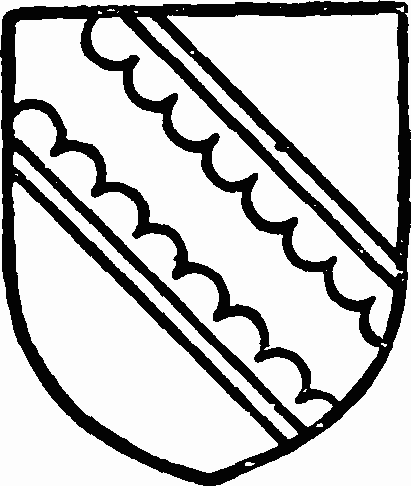
Fortescue of Salden, baronet. Azure a bend engrailed argent cotised or.
The other moiety of Shenley, held by Robert Verdon in 1316, (fn. 94) had passed to his son Robert before 1340, in which year another son, William, renounced the life interest which the younger Robert had given him. (fn. 95) Robert Verdon was still holding in 1346, (fn. 96) but before 1397 the manorial rights of this moiety had been acquired by the overlord, Thomas Beauchamp Earl of Warwick, (fn. 97) lord of Hanslope (q.v.), with which it descended to Richard Beauchamp Earl of Warwick. (fn. 98) In 1408 he released to Thomas Crawe and Robert Huggeford all his right in the manor, (fn. 99) probably in process of transferring it to Richard Lord Grey de Wilton, by whom it was settled in the year of his death on his wife Margaret and his issue by her. (fn. 100) Margaret conveyed her interest in this moiety of Shenley, now called VERDONS MANOR, to Thomas Grey Lord Richemount, (fn. 101) William Grey, her son and heir by Richard Lord Grey de Wilton, releasing his title in the manor. (fn. 102) immediately after her death in 1452. (fn. 103) The two moieties henceforward descend together, and their history has been given under Vaches.
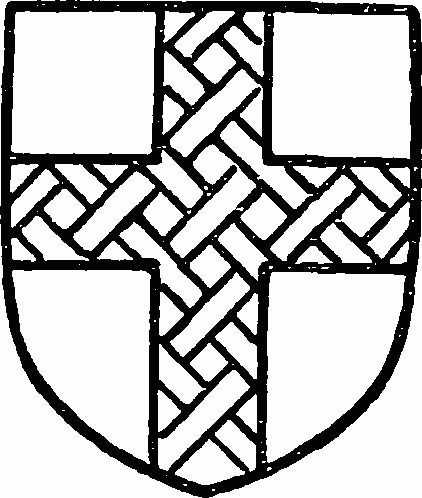
Verdon. Argent a cross azure fretty or.
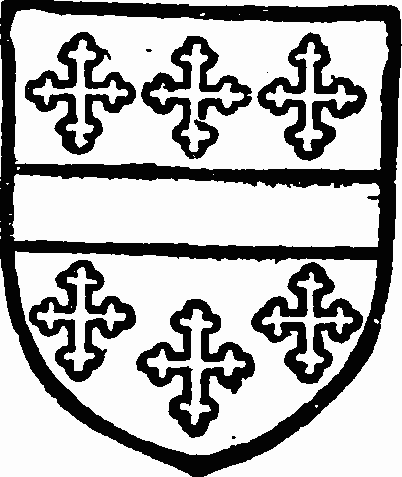
Beauchamp. Gules a fesse between six crosslets or.
The manorial privileges in the 13th century comprised view of frankpledge, held twice a year, and assize of bread and ale, (fn. 104) and were enumerated in the grant of Shenley Manor to Edmund Ashfield in 1563. (fn. 105) Free warren bestowed on Richard de la Vache in 1303 (fn. 106) was still claimed at the end of the 17th century. (fn. 107) Courts leet and baron were held from the 16th to the 18th century, and free fishing was among the appurtenances. (fn. 108)
Two manors is Shenley of 2½ hides each, held in the time of Edward the Confessor by Wlward, one of his thegns, and Morcar, a man of Earl Harold, were assessed in 1086 as the only holdings in Buckinghamshire of Richard Engaine and Urse de Bersers respectively. (fn. 109) The two estates were in Mursley Hundred, afterwards part of Cottesloe Hundred, and united to form the later WESTBURY MANOR which lay in the Cottesloe part of Shenley, the amalgamation probably taking place by the marriage of Richard Engaine with the widow of Richard Fitz Urse. (fn. 110) Richard Engaine's chief manor in 1086 was Benefield (co. Northampton), (fn. 111) the head of an honour to which Westbury was attached (fn. 112) and which passed through the families of Lisures (fn. 113) and Bassingbourne. (fn. 114) In 1278 the overlordship was vested in the heirs of Warner Bassingbourne, (fn. 115) but in the assessment of 1284–6 the manor was said to be held of the king, (fn. 116) and the Crown was returned as overlord until the 17th century, (fn. 117) the service rendered being one-tenth of a fee with 5s. for hidage. (fn. 118)
A manor of 2½ hides in Westbury entered in the Domesday Book under Mursley Hundred has been taken to be Westbury Manor in Shenley owing to the hundredal heading. (fn. 119) It was then, however, among the possessions of Roger de Ivri, whose lands afterwards went to form the honour of St. Valery. (fn. 120) There is no trace of this honour in Shenley, to which, moreover, the other 2½-hide manor of Westbury, in Stodfald, now Buckingham Hundred, was later attached. (fn. 121) The owner of this second manor, the Bishop of Bayeux, had as tenant Roger, (fn. 122) who may be identical with Roger de Ivri, and it is possible that both these manors, one held in chief and one under the bishop, were in Stodfald Hundred, and that a later amalgamation took place, owing to the manorial rights being held by one and the same lord. (fn. 123)
There is no record of the subinfeudation of Westbury Manor in Shenley until the reign of Henry III, when it was held by Joan de Nowers. (fn. 124) Thomas son of Stephen had lands in Shenley about 1226, (fn. 125) and may have been related to Eustace son of Thomas, after whose death Henry III gave Westbury in custody to Terry (Turricus) Allmain, in possession in 1278. (fn. 126) Thomas son of Eustace or Thomas Fitz Eustace, who attained his majority in 1284, (fn. 127) received a grant of free warren in Shenley in 1292. (fn. 128) In 1320 he obtained licence to have an oratory in his house at Shenley, (fn. 129) and in 1327 he settled the manor on himself and his wife Agnes and their issue with remainder to his daughter Joan and her heirs. (fn. 130) At his death about 1341 his wife Agnes had the custody of their son Thomas, aged thirteen. (fn. 131) He evidently died without issue male, for at Agnes's death in 1361 Shenley Manor passed to her son and heir John Fitz Eustace, aged twenty-two. (fn. 132) John Fitz Eustace died in 1369, (fn. 133) and this manor was assigned in dower to his widow Christine. (fn. 134) She afterwards married Sir William Berland, to whom the marriage of Philip son and heir of John Fitz Eustace was granted in 1385. (fn. 135) Philip Fitz Eustace and his wife Blanche enfeoffed Thomas Percy Earl of Worcester and others of Westbury Manor, to the intent that it should be reenfeoffed to them in fee simple, but the Earl of Huntingdon, one of the feoffees, contrary to this order and without the consent of his co-feoffees, enfeoffed Thomas Shelley, kt., at whose execution and forfeiture in 1400 Westbury escheated to the Crown. (fn. 136) The Earl of Worcester, however, re-entered the manor without licence and enfeoffed Philip Fitz Eustace and Blanche, (fn. 137) who obtained the king's pardon in January 1402–3, (fn. 138) and in June of that year they enfeoffed Nicholas Wolbergh, John Whitwell and others, (fn. 139) a renunciation of right being made in the following month by Agnes Verdon, daughter of Thomas Fitz Eustace. (fn. 140) Notwithstanding the legalization of this transaction by the king, (fn. 141) in December of that year he granted Westbury as a forfeiture of Thomas Shelley to John Cope for life. (fn. 142) The grant appears to have been ineffective, and in the following February 1403–4 the feoffees' title was strengthened by a renunciation of rights from John Hartshorn, from whom Philip Fitz Eustace had borrowed money. (fn. 143) In the following December the feoffees obtained a release of claim to Westbury from Richard brother and heir of Thomas Shelley. (fn. 144) The manor was held to the use of Nicholas Wolbergh and his heirs, and after the death in 1419 of John Whitwell, the surviving feoffee, Westbury passed to Cecily daughter and heir of Wolbergh and wife of William Sydney. (fn. 145) In 1430 they settled Westbury on themselves and their sons William and Richard in tailmale, (fn. 146) and it was apparently the son William who died seised of the manor in 1462, leaving two infant daughters, Elizabeth and Anne, who afterwards married John Hampden and William Uvedale respectively. (fn. 147) The Uvedales before 1512 appear to have renounced their interest in the manor to Thomas Stafford of Tattenhoe, who made a settlement of it that year, (fn. 148) and to whom the Hampdens shortly afterwards quitclaimed their rights. (fn. 149) Westbury has since descended with Tattenhoe (fn. 150) (q.v.) to Mr. W. Selby Lowndes, the present owner, though the manorial rights have long since been obsolete. There are references to a windmill on Westbury Manor in 1278 (fn. 151) and 1342. (fn. 152)
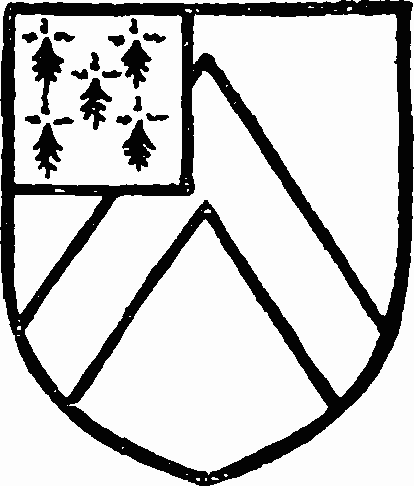
Stafford of Tattenhoe. Or a cheveron gules and a quarter ermine.
In 1278 the priory of Snelshall held 1½ virgates in Shenley and half a virgate in Westbury, (fn. 153) and paid rent to Woburn Abbey. (fn. 154) From this estate 12d. rent each was paid in 1535 to Francis Pigott and to —Hampden, (fn. 155) the former of whom received a grant of the property in 1539. (fn. 156) Two years later, however, it passed with Shenley Manor to the Crown.
Lands in Shenley belonging to Bradwell Abbey descended with Bradwell Manor (q.v.) to Sheen Priory. (fn. 157) The gild of St. Margaret and St. Katherine, Fenny Stratford, had a farm-house with dove-house and 60 acres of land worth £20 yearly in Shenley, to which Sir John Fortescue, bart., of Salden, Mursley, put forward a claim in 1656. (fn. 158) This property known as Dovehouse Farm, which was leased by Sir John or his son in 1680, was afterwards bought by John Knapp, (fn. 159) purchaser of the principal manor in Shenley, into which it became absorbed.
Church
The church of ST. MARY consists of a chancel measuring internally 23 ft. 6 in. by 14 ft. 6 in., north vestry, central tower 14 ft. square, north transept 12 ft. by 11 ft., south transept 12 ft. by 10 ft., nave 39 ft. 6 in. by 17 ft. 6 in., north and south aisles, both 7 ft. 6 in. wide, and south porch. It is built of rubble, and the roofs are covered with lead and tiles.
The church dates from about 1150, and originally consisted of chancel, nave, north and south transepts, and perhaps a central tower; but both the chancel and tower have been rebuilt, and the only parts of the original structure remaining are the transepts and the west wall of the nave. About 1190 the chancel was rebuilt and the south aisle added; the latter, however, was rebuilt about 1350, when the north aisle and the nave clearstory were also added. The tower was rebuilt about 1490. The porch probably dates from the 17th century, but has been considerably repaired, and the whole fabric was restored in 1888–90. The vestry is modern, but stands on the site of a chapel or sacristy built about 1180 and destroyed when the tower was rebuilt.
The chancel was originally vaulted in two bays, and the richly carved triple corbels which supported the transverse and diagonal ribs are still in position in the middle of the north and south walls, but the vault has been destroyed. Some stones from the moulded ribs have been re-used in the rear arch of the east window, while a sculptured stone lying at the south-west is probably one of the bosses. The eastern bay retains its original windows in the north and south walls, and the western bay has an original window on the south. All these are single pointed lights with moulded external arches of one order and rear-arches of two orders, supported generally by shafts with foliated capitals and moulded bases, most of the shafts having annulets. On the north is an original round-headed doorway, which was evidently designed to open into an adjoining building, probably a sacristy. The east wall is almost entirely occupied by a large five-light window with a four-centred head of about 1490, which has been considerably repaired. A three-light window of the same period has been inserted at the north-west, and opposite to it, at the west end of the south wall, is a low-side window of early 15th-century date, while between the original windows on the south is a roundheaded doorway of about 1400. Both the north-west window and the north doorway now open into the vestry. There are two lockers in the chancel, one on the north and the other on the south, and at the south-east is a double trefoiled piscina, probably of the 14th century, with a restored circular bowl, while below the south-east window are two restored sedilia of the 13th century under one segmental arch with a moulded stone seat and dividing arm, the arm being enriched by an attached shaft. The low-pitched moulded roof is of the 16th century.
The ground stage of the tower communicates on all sides with the chancel, nave, and transepts respectively by wide pointed arches of late 15th-century date, each having three orders springing from chamfered responds with moulded capitals and bases. The north transept, which now contains the organ loft, has a restored 14th-century window of two lights with tracery in the north wall, and a small round-headed window of the mid-12th century over a modern doorway in the east wall. A 14th-century pointed arch, the south respond of which has been replaced by the north-west pier of the tower, communicates with the north aisle on the west. The south transept is of similar character but with slightly different detail; in the east wall is a small 12th-century window, now blocked, while an early 14th-century window of two trefoiled lights with tracery has been inserted in the south wall. The transept opens to the south aisle on the west by a 14th-century arch, which has been treated in the same manner as that on the north. There is a locker on the south, and a rich 12th-century capital has been built into the wall at the north-east.
The nave has north and south arcades of four bays with pointed arches. The south arcade, which dates from the end of the 12th century, is supported by circular piers with crudely formed capitals and square abaci. The north arcade is of about 1350, and the arches rest on octagonal piers with moulded capitals and bases. Both arcades have been repaired. The eastern arches on both sides have been encroached upon by the piers of the tower, which have entirely replaced the east responds. At the west end of the nave is a pointed doorway of the 14th century and above it is a large 15th-century window of five cinquefoiled lights under a four-centred head, both of which have been extensively repaired. The clearstory is lighted from the north by three plain windows of two trefoiled lights, and from the south by three pointed two-light windows with tracery, all of which, though considerably restored, date from the 14th century.
In the north wall of the north aisle are three traceried two-light windows of about 1350 and a moulded doorway, now blocked, of the same period; all the windows have been restored. In the west wall is a modern two-light window. The details of the south aisle are similar in character to those of the north. There are three 14th-century windows of two lights in the south wall, which have also been repaired, and a modern window at the west end. The south doorway is also modern.
The tower rises two stages above the church roof and is surmounted by an embattled parapet; the stair turret at the north-east, which is continued above the parapet, is also embattled. The turret was originally entered by a doorway in the north transept, but this has been blocked and a new doorway opened from the vestry. There is a window of three lights, one glazed and two blind, in each of the north and south walls of the intermediate stage, and the bell-chamber is lighted from all sides by two-light windows with four-centred heads, all being of the late 15th century. On the east and west walls are the weatherings of earlier high-pitched roofs.
The font, which has an octagonal panelled bowl, dates from the 15th century. In the chancel are two slabs, one with a brass inscription to Thomas Thurleby, rector (d. 1432), and the matrix for his figure, and the other with the matrices for a figure and inscription. There is also a marble monument with arms to Sir Edmund Ashfield (d. 1577) and Eleanor his wife. The monument consists of a recess containing a white marble sarcophagus and framed by Corinthian columns supporting an entablature and broken pediment. In the north aisle is a large monument to Thomas Stafford of Tattenhoe (d. 1607), with a reclining alabaster effigy in armour of the period. On the front of the tomb are the kneeling figures of his wife, their four sons and three daughters, each of the sons bearing the arms of Stafford, and the daughters those of their respective husbands, Bernard, Thakeston, and Savage, each impaling Stafford. On the wall above the effigy is an inscription in an architectural setting surmounted by the arms of Stafford of Tattenhoe, quartering Hastang, Burdett and Aylesbury. Some 17th-century carved panels are incorporated in the pulpit, and the legs of the communion table in the south transept are of the same period.
The tower contains a ring of six bells; the treble is modern, while the second and third are by Newcome, 1615 and 1616 respectively, and the fourth and fifth by Bartholomew Atton, 1593 and 1610. The tenor, which bears the inscription 'Missi De Celis Abeo Nomen Amen Gabrelis,' was probably cast by Robert Burford in the early 15th century. (fn. 160) There is also a small bell with no inscription, but probably of the 17th century.
The plate consists of an 18th-century chalice and paten, and a modern flagon.
The registers begin in 1653.
Advowson
The advowson of the church of Shenley, mentioned in 1223, (fn. 161) descended with the manor until about the middle of the 19th century, since then it has been held by a succession of owners, incumbents of Shenley. (fn. 162) The church was valued at £12 yearly in 1291 (fn. 163) and at £23 in 1535. (fn. 164)
Rents amounting to 11s. 4d. were applied to the keeping of obits and maintenance of a lamp, (fn. 165) and the property from which they issued was granted to Sir Edward Bray in 1553. (fn. 166) Hugh Earl of Chester bestowed the tithes of Shenley on the abbey of St. Evroul, Normandy, to which Ralph Earl of Chester confirmed them in 1121–9. (fn. 167)
Charities
The almshouses, erected about 1615, under the will of Thomas Stafford of Tattenhoe, consist of six cottages endowed with a rent-charge of £35 issuing out of an estate at Great Linford; they are regulated by a scheme of the Charity Commissioners of 17 March 1882. By the scheme the inmates are limited to three in number, the remaining cottages being let and the rents applied in augmentation of the income of the charity.
The Bread Charity.— Robert Seeling, by his will proved in the P.C.C. 8 November 1681, devised £3 yearly to the poor in bread. The annuity is paid out of land formerly called Nether Lawn, now the property of Mr. Richard Selby-Lowndes.